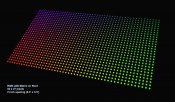blueabacas
New elf
- Joined
- Aug 14, 2012
- Messages
- 5
Hi Everyone,
I'm hoping to get some feedback/advise on a RGB pixel matrix for my roof. I'm thinking right now it will be roughly 27 strings of 50 pixels at about 2 inch spacing. I've been reading over the forums and I've seen a few examples, but I just wanted to see if my layout/design looks generally good. I'm also thinking instead of standing upright due to high winds I'll try to mount the strings right along the angle of the roof (see image).
[attachimg=1]
Could I use a long thin coro strip which is scored to bend up to create an L, then cut holes along the strip and insert the leds through? So each led string would have it's own coro strip. Then brace the strip with a metal L bracket from behind.
[attachimg=2]
Here is where I'm at with the setup:
Lights: 27 x WS2811 50pcs DC5v
Would these work as good as the 2801 lights I've seen other people use? Would the 5v work ok for my layout?
Controller: 1 x ECG-P12R - 12 universes
Could I run 3 strings continuously per output (50 pixels/string, 150 channels/string, 3 strings = 450 channels)? Using 9 total outputs. How often would I need to inject power?
Power: Ray Wu 350w 5v
or a few of the smaller 60w 5v power supplies to inject down the line
Thank you for any help or suggestions!
I'm hoping to get some feedback/advise on a RGB pixel matrix for my roof. I'm thinking right now it will be roughly 27 strings of 50 pixels at about 2 inch spacing. I've been reading over the forums and I've seen a few examples, but I just wanted to see if my layout/design looks generally good. I'm also thinking instead of standing upright due to high winds I'll try to mount the strings right along the angle of the roof (see image).
[attachimg=1]
Could I use a long thin coro strip which is scored to bend up to create an L, then cut holes along the strip and insert the leds through? So each led string would have it's own coro strip. Then brace the strip with a metal L bracket from behind.
[attachimg=2]
Here is where I'm at with the setup:
Lights: 27 x WS2811 50pcs DC5v
Would these work as good as the 2801 lights I've seen other people use? Would the 5v work ok for my layout?
Controller: 1 x ECG-P12R - 12 universes
Could I run 3 strings continuously per output (50 pixels/string, 150 channels/string, 3 strings = 450 channels)? Using 9 total outputs. How often would I need to inject power?
Power: Ray Wu 350w 5v
or a few of the smaller 60w 5v power supplies to inject down the line
Thank you for any help or suggestions!




